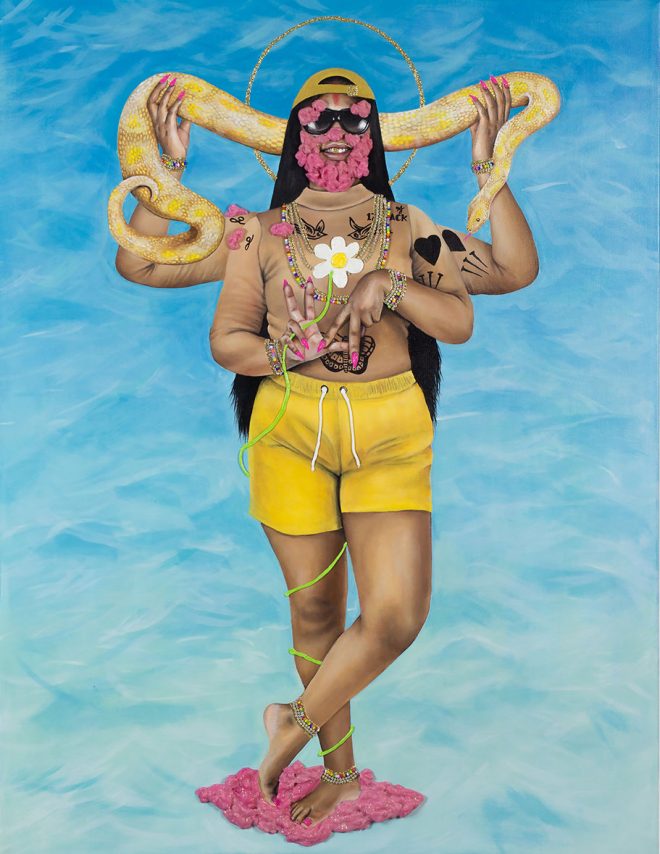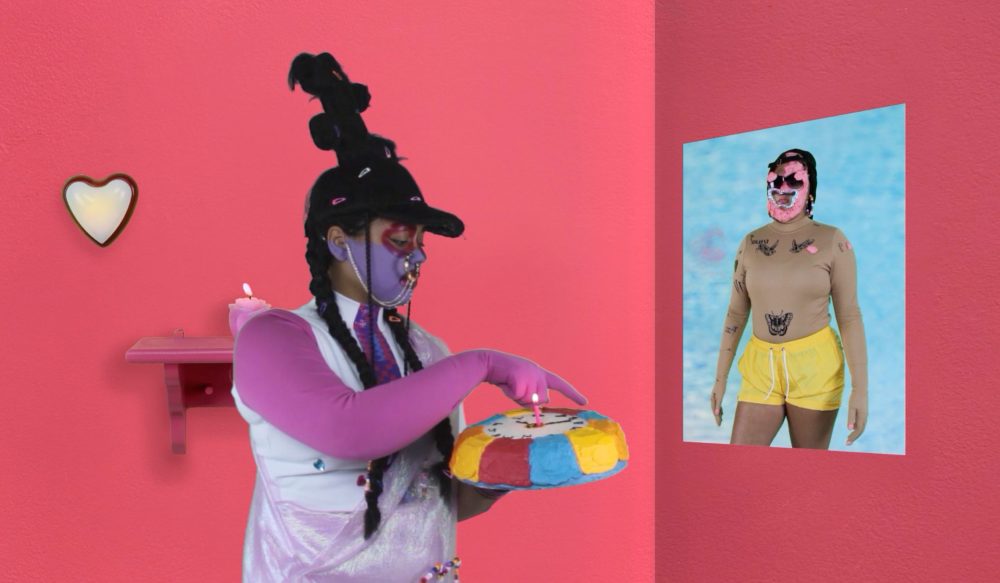Black Girl Mudras: Danya Smith at Good Children Gallery
Nelle Mills visits Danya Smith’s current show at Good Children Gallery and reflects on the artist’s visions of black girlhood.

Danya Smith, I’m a Slave 4 U, 2018. Acrylic and mixed media on canvas. Courtesy the artist.
I went to view Danya Smith’s “Altar Ego” at Good Children Gallery on St. Claude on a quiet Sunday and the gallery attendant mused quietly that she wished Smith’s show was in the bigger of the venue’s two rooms. However, the effect of choosing to house this exhibition in the smaller, more intimate space was immediately obvious. After being greeted by Jessica Bizer’s vibrant paintings at the front door, walking into “Altar Ego” felt like entering a tween’s bedroom that was simultaneously surreal and comforting, nostalgic and timeless. These dualities, which begin with a feeling, take shape and are made visible via Smith’s sculptures, video, and mixed-media paintings.
The paintings, which depict black women posed à la Hindu goddesses, are punctuated by three bubblegum-like sculptures hanging in each corner. In these works, Smith smoothly and unapologetically takes symbols associated with black girlhood—colorful plastic barrettes, two strand twists, silver and gold chains—and asks the viewer to consider which objects are deemed divine and to imagine their journey to sainthood. Finally, a large projected video takes up almost an entire wall and depicts what appears to be a live-action narrative about the paintings and sculptures. A tinkering musical track that teeters between eerie and irritating fills the room.
The fantastical video shows a young black girl, who according to the artist’s statement, is Moodi Judi, “the perpetual twelve-year-old” who rocks braids under a fitted cap and sports a gold door-knocker nose ring. Throughout the video, we witness what appears to be an intimate self-ritual. A floating mouth appears and kisses the air before resting on a clock for a moment. Moodi eats a red lollipop before sharing it with the “floating prophetic mouth,” Desteny. In the video, opposite Moodi, there is a poster, which depicts a black femme sporting yellow Soffe shorts, a nude mesh bodysuit, and an oozing pink mask.

A still from Danya Smith’s Altar Ego, 2018. Single-channel video with sound. Courtesy the artist.
The mouth floats lazily from the poster while Moodi takes the clock from the wall, puts a candle in the center, and refashions it into a birthday cake of sorts. Desteny returns to Moodi, opens her mouth and vomits out a silver chain before returning to the poster. Moodi takes a lick of icing from the clock-cake and with her finger, rubs it on the poster, who then comes alive, joining her hands in prayer position, while another set of hands simultaneously emerge from her back, holding a black whip and a pink glittery diary. Moodi releases the cake and it ascends to the heavens as the figure in the poster attempts to step out of the frame.
The figure hands Moodi the diary, who opens it to reveal another crumpled silver chain. Desteny reappears, opens her mouth, is fed the chain, and once again ferries it to the poster who adorns herself with it. This continues with more objects until the diary is empty. Moodi hands it back to her poster before the clock-cake descends from the heavens. Desteny blows out the candle. The poster blows Moodi a kiss before she replaces the clock on the wall. The poster’s extra limbs have retracted back into her body as Desteny frames herself into a heart before fading quietly into the nothingness.
After viewing the video, Smith’s paintings are obviously renderings of the poster with which Moodi and Desteny interact. All three paintings take the form of the poster, its figure symbolically posing with extra limbs holding objects such as notebook paper, daisies, gold chains, waist beads, and snakes. Each Shiva-esque figure has a halo and each figure’s face is obscured with a gummy substance and sunglasses so that only her mouth is visible. Each smile is identical, unwavering in its perfection.
What is most notable about the paintings are not just the objects held, but the ways in which the figure poses. In one painting, the three-armed woman sits cross-legged; one hand holds a golden, glittery trident; another with pink acrylic nails makes a fist. Dangling between another set of fingers, which are fashioned in the OK sign, as if she’s about to let them go, a long strand of sculptural waist beads hangs out of frame. By shamelessly placing the black power fist opposite the gyan mudra, which represents individual and collective conversation and consciousness, Smith is placing the symbols of a black girlhood and eventual womanhood in their rightful sacred places.
Editor's Note
Danya Smith’s “Altar Ego” is on view through October 7, 2018, at Good Children Gallery (4037 St. Claude Avenue) in New Orleans.



